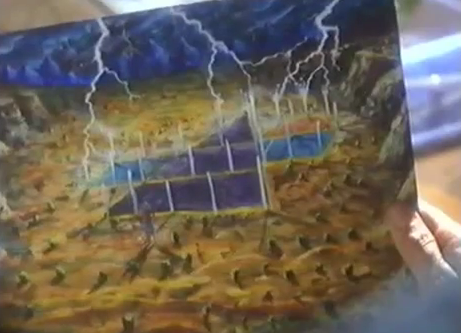Lightning Field, which aired on September 11th, 1991, is about a very pregnant artist named Margaret (Nancy McKeon looking really gorgeous… as usual) who finds most of her creative inspiration in her dreams. These imaginings are of people and places she’s never seen in real life, but her visions become quite a concern after she manifests a snake from her nightmare/hallucination into her own home! A dream therapist named Vivian (the lovely Tantoo Cardinal) guides Margaret through the discovery of long kept secrets about her past as she finds that she’s connected to a community of South Americans who think Margaret’s baby is the chosen child. Chosen for human sacrifice, of course! (I should note though that the ditzy way Margaret acts early on - climbing a dangerous ladder with a nine-month belly going on - made me wonder if “cult” is actually code for child services!)
As you may have guessed, a lot of crap hits the fan, from Margaret losing her husband on the day she gives birth (talk about an emotional day!) to having her baby kidnapped and taken to another country to watching her mom’s face ooze blood from every orifice (yuck), to realizing that she has cool psychic powers that can wield lightning!
That’s a whole lot to take in, but what is even more interesting than the throw-it-all-into-the-pot-storyline is how the film uses two very disparate but fairly well known American subjects as plot devices. The first is Walter De Maria’s stunning earth art work titled, ahem, Lightning Field. While the mimicking of this art piece is only shown briefly, anyone who has studied art history or just enjoys land sculptures will probably be feeling some kind of déjà vu! And it looks like the "inspiration" wasn’t lost on the art world either because the owners of De Maria's work, the DIA Foundation sued the film's production company, Wilshire Court Productions!
 |
| Margaret's Lightning Field |
 |
| Walter De Maria's Lightning Field |
Here's a great quote from an article about the suit:
"They argued that the earthwork in Lightning Field was not constructed by Walter De Maria, but Facts of Life alum Nancy McKeon. Also, De Maria's The Lightning Field has inspired generations of artists to examine the complex relationship between man and nature, while McKeon's Lightning Field inspired a cult of obsessed baby snatchers to kidnap her child and use it as a sacrificial offering. To no ones surprise, the owners of the earthwork, The DIA Art Foundation, were not impressed and moved to sue the production company for violation of copyright." (underlined emphasis mine!)
The testimony excerpt used for the above article is hysterical and I highly recommend you spend a few minutes with it. According to these selected court records the producer had already shopped around a script about a land artist named William Van Marta.
Oh my.
This might be why the title was later changed to The Lightning Incident! I have no idea how this case turned out, so if anyone has the deets, please let me know!
The second inspiration is a bit more vague and seems a lot less plagiaristic, but is still noticeable if you have studied African American history. The Tuskegee Syphilis Experiment is one of more diabolical medical experimentations that I am familiar with, and I couldn’t help but think the South American cult member’s malaria treatment was a reworking of that harrowing true story. Watching Lightning Field with modern eyes is likely to generate some criticism about the blood hungry South Americans, but once their story is revealed, this becomes a tale about heartbreak, revenge, and the importance of legacies, moving the film beyond some of its misguided shortcomings. Not too far beyond, but enough to make it more fun than not.
And at the same time, Lightning Field also has a marginal lightning duel, some super cool 90s hair via Elpidia Carrillo, awesome adobe houses and some low brow Rosemary's Baby action. Despite an all over the map kind of feeling, McKeon and Tantoon are both likable and strong personas that carry this oddball and engaging thriller.
Lightning Field is on VHS (as Lightning Incident)!

















